1. Introduction
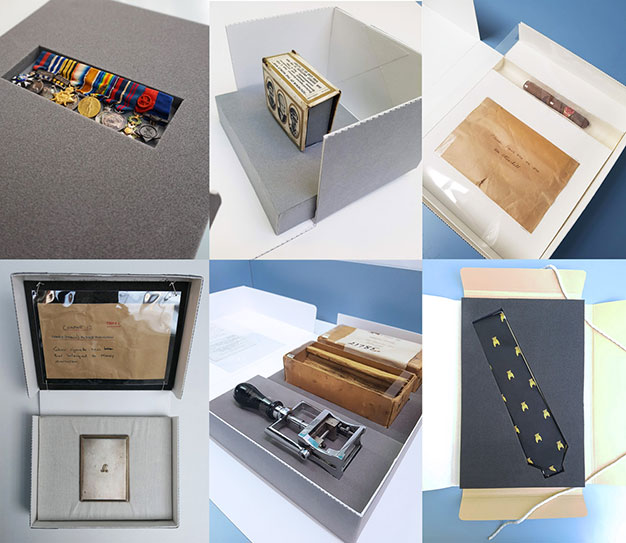
Figure 1: On the above picture are six different artefacts that have been housed in our conservation studio last year (from left to right): A set of medals that belonged to Admiral Sackville Hamilton (1857-1930); A matchbox that was made in the UK as a souvenir of World War II; A cigar that had been gifted by Winston Churchill during an event in Aberdeen in 1946; The cigarette case of Mary Agnes Hamilton; The metal stamp used by the Chartwell Trust; A Churchill tie that belonged to a Churchill College drinking society.
The objective of the Archives Centre is to conserve and preserve its historic collections in order to make them accessible for today’s researchers and future generations. If the Churchill Archives Centre mainly holds documents on paper, our artefacts collection contains highly sought after objects such as Thatcher’s bag, a Winston Churchill cigar or Nobel Prize medals. In comparison with some museums with large exhibitions welcoming thousands of visitors per year, we regularly install small exhibitions in our display cases or on our reading room’s tables for booked groups of visitors in order to promote the collection and answer to the demand. We often prefer to display facsimiles instead of our original paper documents to reduce handling and risks of damage but this is not an option when it comes to exhibiting artefacts. Since our displays are short and usually do not last more than a day, objects are handled more often and there is a higher risk of damage because of handling. To deal with this problem, myself and our senior conservator produce for each object one bespoke box that will not only house the object and protect it from the environment, but will also be used as a mounting for displays. The aim is to facilitate the exhibition process for our archivists who put displays in place so they only have to put the box on the table and open the lid without ever having to touch the object.
All our boxes are made with stable materials such as acid-free boards, polyethylene foam (also called Plastazote) or 100 % unbleached cotton fabric. We try as much as possible to avoid applying paste but if we do, we use wheat starch paste – a natural paste used for its stability and purity – or a neutral pH synthetic adhesive called EVA-con. Boxes are always made-to-measure and some box designs can become quite complex to create an adequate housing for the object while making it aesthetically appealing and easily accessible for visitors. Let’s see three recent examples in detail.
2. Examples
a. The stamp
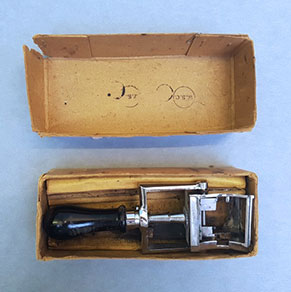
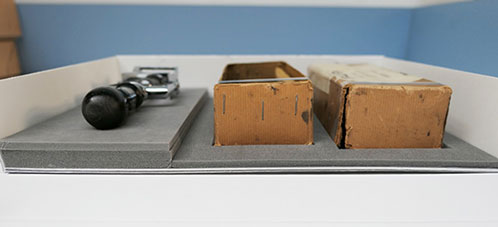
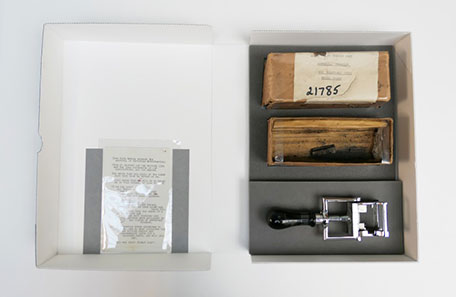
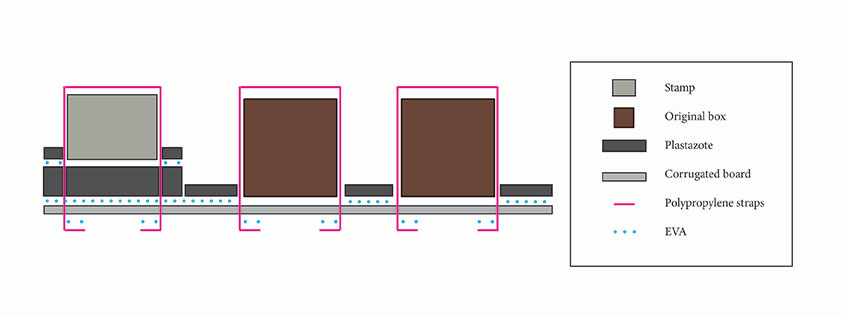
This metal stamp was used by the Chartwell Trust on a large amount of Churchill’s papers including his ‘finest hour’ speech. The original box and its stamp were housed together in the same box made of Plastazote and corrugated board and all parts of the object were fixed with polypropylene straps. Now the objects do not need to be handled in order to be seen, which is especially important for the metallic stamp as metal should not be handled without gloves to avoid leaving fingerprints. As you can see on the photo, we placed a facsimile of the ‘finest hour’ speech into the box as a little exhibition addition for the visitors to better understand what the stamp was used for.
b. The cigarette case
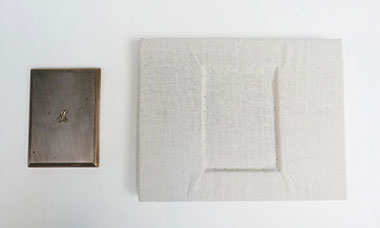
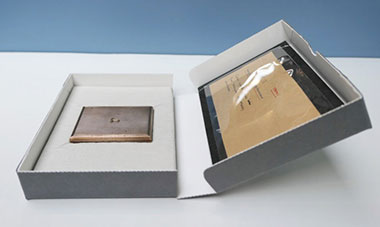
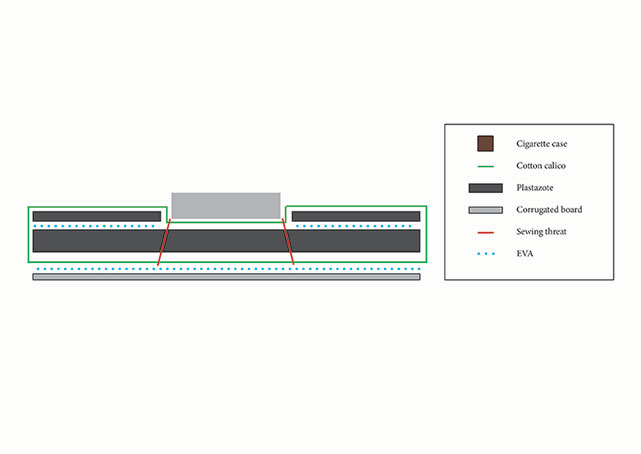
This cigarette case belonged to Mary Agnes Hamilton, one of the first MPs in the UK who won one of two seats for Blackburn in the 1929 general election. The object was loose and had to be housed properly.
Since the case will be displayed within its box, more attention was given to the colour support in order to highlight the object as much as possible. The colour of the grey Plastazote was too similar to the colour of the cigarette case so a light coloured and unbleached piece of cotton fabric was sewn to the polyethylene foam to cover it.
In order to create a mini display within the box, the envelope that originally protected the cigarette case was enclosed in a polyester sleeve which was sewn to the lid of the box in order to make it visible during display.
Unlike the stamp, no strap was added to fix the cigarette case to its support so the back will be easily accessible. However, a piece of polyethylene foam was stuck to the lid to hold the object in place when the box is closed.
c. The matchbox
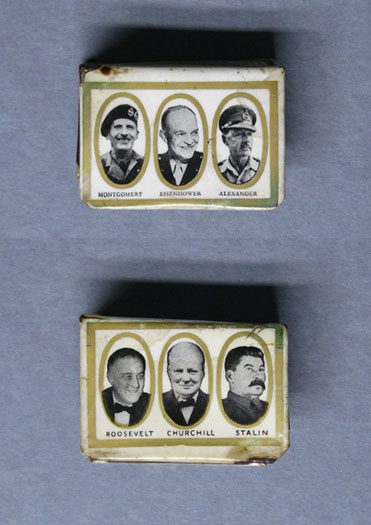
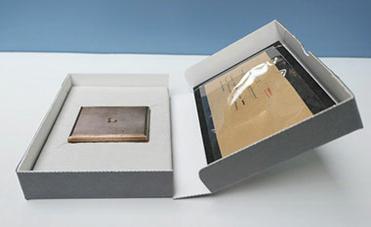
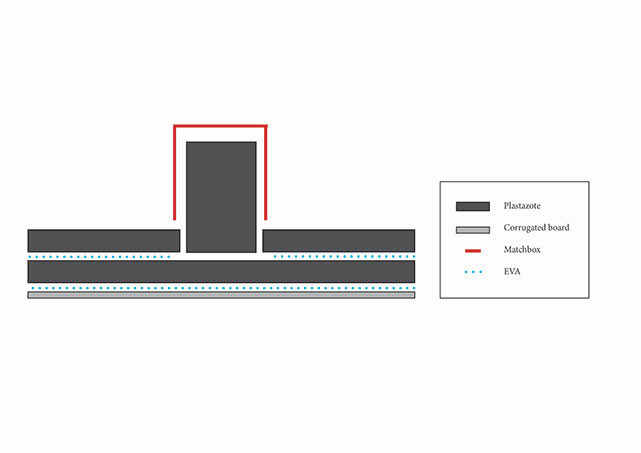
This matchbox illustrating major political characters such as Churchill, Roosevelt, Eisenhower or Stalin was made in the UK as a souvenir of World War II. The object had to be visible from every angle as illustrations were on both sides of the matchbox. Plastazote and corrugated board with a little bit of EVA-con were used to create this box. The object was not likely to move when placed on the polyethylene foam, therefore no additional strapping was added. The matchbox can now be handled by holding the platform and appreciated from every angle without having to touch it.
Finally, for each project, specific labels are stuck on the box in order to raise awareness of the fragility of the object and give advice on how the box should be handled.
3. Conclusion
These examples are only a few of the artefacts that are conserved at the Archives Centre but it shows how diverse the collection is and how conservators must adapt to any particularities of each one of them.
Boxing may not sound very glamorous but it is a big part of our job as conservators. Housing objects will greatly reduce risks of damage, especially on objects that are often put on display such as Margaret Thatcher’s bag or Winston Churchill’s cigar, and increase chances for the objects to be seen and handled by future generations.
— Erica D’Alessandro, Conservator
Subscribe to Churchill Archives Centre News
Subscribe to the Churchill Archives News RSS feed:
